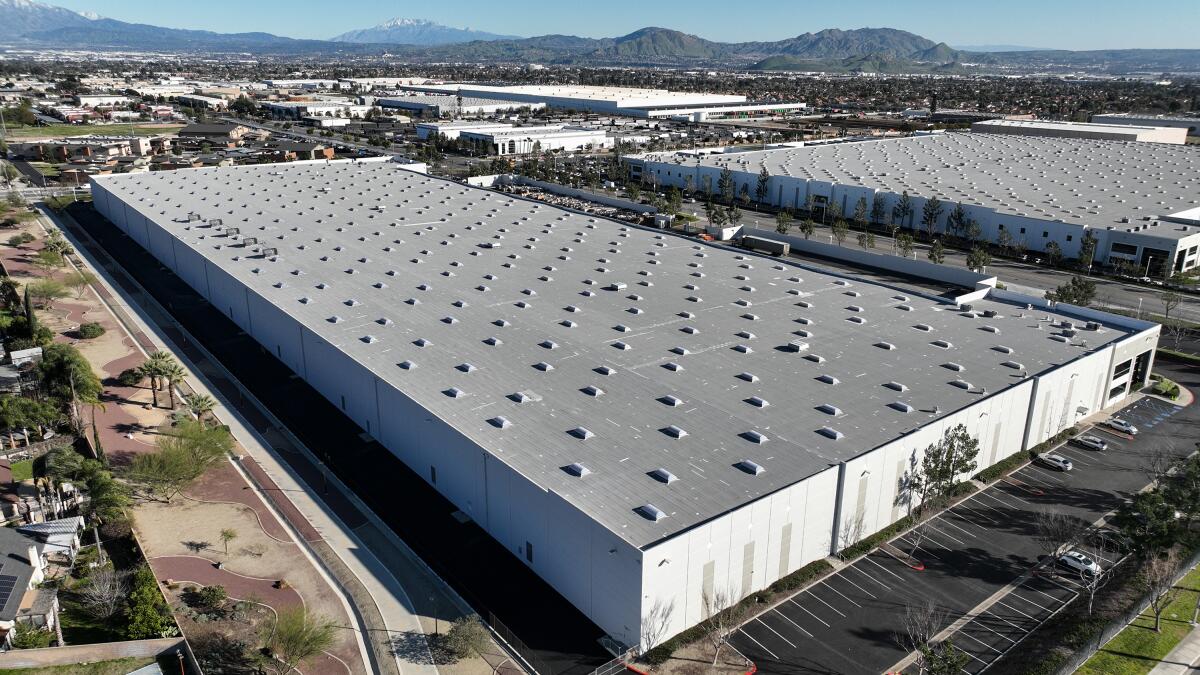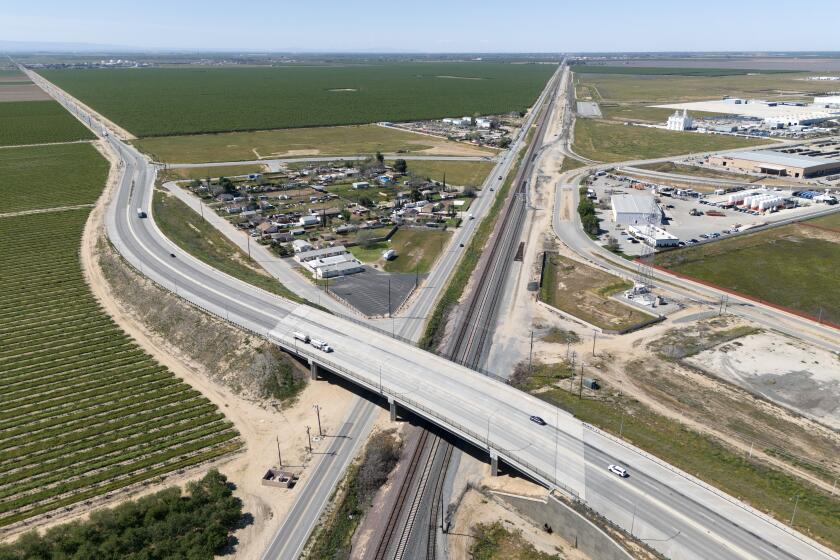Why a bill to regulate California warehouse development is generating sweeping opposition

- Share via
Xochitl Pedraza moved to San Bernardino County eight years ago. After three decades of city living, unincorporated Bloomington offered a rural community where she could buy an acre of land and raise chickens.
But Pedraza’s neighborhood has become more industrial in recent years, as developers have converted large swaths of property along the 10 Freeway into a logistics corridor for e-commerce, connecting goods shipped into Southern California ports with online shoppers across the nation. Although proponents of the developments say they bring jobs and infrastructure improvements, many residents living in their shadow lament the pollution, traffic and neighborhood disruption.
There was already an avocado distribution center across the street from Pedraza’s home; now there’s an Amazon fulfillment center on the corner that brings “trucks after trucks after trucks,” Pedraza said. The incessant beeping and honking penetrate her soundproof windows.
She and her 8-year-old grandson suffer from dry eyes, nasal congestion and a chronic dry cough — symptoms she attributes to dust from warehouse construction and the region’s ozone pollution.
A bill on Gov. Gavin Newsom’s desk would establish siting and design standards for industrial warehouses that, according to supporters, would better protect the health of residents such as Pedraza.
Assemblymember Juan Carrillo (D-Palmdale), co-author of the legislation, has described the measure as a “very delicate compromise” that resulted from lengthy negotiations among a working group that included labor, health, environmental and business representatives.
Nonetheless, the bill has generated staunch opposition from a diverse range of environmental, community and civic groups statewide who object to the secrecy in which the bill was crafted in the final days of the session and who say it fails to hold warehouse developers to higher standards.
Beginning in 2026, AB 98 would prohibit cities and counties from approving new or expanded distribution centers unless they meet specified standards. New warehouse developments would need to be located on major thoroughfares or local roads that mainly serve commercial uses. And warehouse sites would need to be set back several hundred feet from so-called “sensitive sites” such as homes, schools and healthcare facilities.
Additionally, if a developer demolishes housing to make way for a warehouse, the bill would require two new units of affordable housing for each unit that is destroyed. The developer would have to provide displaced tenants with 12 months’ rent.
Some regulations would need to be enacted in the state’s “warehouse concentration region” — Riverside and San Bernardino counties and a dozen Inland Empire cities — by 2026, two years before the rest of the state.
Although some labor groups support the bill, it is opposed by a host of environmental, business and community organizations. Several cities also opposed the legislation, which, according to an analysis by the Senate Appropriations Committee, requires general plan updates that could result in one-time costs for cities and counties ranging from tens of millions to potentially hundreds of millions of dollars.
Environmental advocates are especially concerned about the bill’s setback requirements for projects involving warehouses 250,000 square feet and larger that are within 900 feet of homes, schools, parks or healthcare facilities.
In those cases, the bill would require that truck loading bays are located at least 300 feet from the property line in areas zoned for industrial use and 500 feet from the property line in areas not zoned for industrial use. Warehouses would also need to comply with design and energy efficiency standards.
Pedraza, the Bloomington resident, said the distances laid out aren’t enough buffer. The rules also don’t take into account that truck traffic and pollution issues are magnified in overburdened communities such as Bloomington, she said.
“The whole community is surrounded by warehouses now,” she said. “It doesn’t matter how far it is ... they still affect us.”
Bloomington is the latest Inland Empire community to weigh the tradeoffs of allowing a developer to bulldoze a rural neighborhood to make way for a sprawling warehousing complex in service of online shopping.
The bill would simply enshrine current warehouse development practices into law and undermine local efforts to advocate for the much bigger setbacks recommended by state agencies, said Andrea Vidaurre, senior policy analyst for the People’s Collective for Environmental Justice in San Bernardino.
In a 2022 report on best practices for warehouse projects under the state’s environmental laws, the state attorney general’s office recommends locating warehouse facilities so that their property lines are at least 1,000 feet from the property lines of sensitive sites such as homes and schools. It cites the state Air Resources Board, which in 2005 estimated an 80% drop-off in pollutant concentrations at approximately 1,000 feet from a distribution center.
“If this is signed into law, we’re basically saying, ‘Business as usual is OK; let’s keep building it like this,’” Vidaurre said. “We’re going to continue to see warehouses being put across the street from homes and schools, because it will be OK with the law.”
Assemblymember Eloise Gomez Reyes (D-Colton), another co-author, acknowledged during a Senate committee hearing last week that AB 98 preserves jobs and enacts warehouse standards but is “not the perfect bill.”
She introduced a bill earlier this year that said warehouses could be sited within 1,000 feet of schools, homes, healthcare facilities and other sensitive sites only if they included a minimum setback of 750 feet and adopted specific mitigation measures. The bill was held in its first committee.
Gomez Reyes said the distance requirements in AB 98 could serve as a floor.
“I do not believe the sensitive receptor setbacks in this bill adequately protect our most vulnerable communities,” Gomez Reyes said during the hearing. “It is important to note that these, however, are only a minimum. And nothing in this bill stops cities or advocates from pushing to put in place stronger standards with local cities and counties.”
The Wonderful Co., known for its pomegranate juice and pistachios, is pursuing a massive warehousing complex in Kern County that would fundamentally transform the economy in a region long reliant on agriculture and oil.
Karla Cervantes launched the Mead Valley Coalition for Clean Air earlier this year to fight the proliferation of warehouses in her unincorporated community of about 20,500 people in Riverside County. She said developers aren’t going to agree to setbacks larger than what’s required in the legislation.
Riverside County already recommends warehouses be designed so there’s at least 300 feet between the property line of a sensitive site and the nearest dock door. Although it is “very rare” for developers to agree to a larger setback, she said, they will sometimes offer larger landscaped buffers to obscure people’s view of facilities.
If AB 98 becomes law, she said, “it’s going to be even harder for us to try to push for better.”
Newsom has until Sept. 30 to sign or veto the bill.
This article is part of The Times’ equity reporting initiative, funded by the James Irvine Foundation, exploring the challenges facing low-income workers and the efforts being made to address California’s economic divide.
More to Read
Sign up for Essential California
The most important California stories and recommendations in your inbox every morning.
You may occasionally receive promotional content from the Los Angeles Times.













